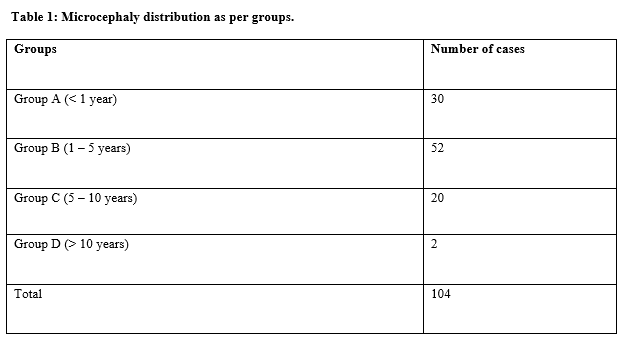Assessment of the clinical profile in the children with microcephaly: Random sampling study
Abstract
Background and Aim: Primary Microcephaly is also associated with at least 7 gene loci, and 7 single etiologic genes have been identified. Acquired microcephaly can be seen in conditions such as rett, seckel, and angel syndromes and encephalopathy syndrome associated with severe seizure disorders. Hence the study was done to assess the clinical profile of microcephaly in children.
Materials and Methods: A total of 104 children were included in the study. The children were divided into different groups as per age distribution. Group A consist of children of age less than 1 year, in group B there were children between age 1 – 5 years, in group C the age of children included was 5 to 10 years and in group D the age of children was more than 10 years.
Results: There were 30 children with microcephaly in group A, in group B there were 52 children with microcephaly. For group C there were 20 children with microcephaly and for group D there were 2 children with microcephaly. The maximum numbers of children were in the age group of 1 to 5 years.
Conclusion: Microcephaly is a frequent clinical sign which is common in many of the rare diseases, henceforth, as the exact diagnosis is important for counseling the patient and the affected family, regarding the clinical course, possible complication, optimized medical support, and recurrent risk.
Downloads
References
COWIE V. The genetics and sub‐classification of microcephaly. J Intellect Disab Res. 1960;4(1):42-47. doi: 10.1111/j.1365-2788.1960.tb00751.x.
Mitchell W. Neurological and developmental effects of HIV and AIDS in children and adolescents. Mental Retard Develop Disab Res Rev. 2001;7(3):211-216. doi: 10.1002/mrdd.1029.
Devakumar D, Bamford A, Ferreira MU, Broad J, Rosch RE, Groce N, Breuer J, Cardoso MA, Copp AJ, Alexandre P, Rodrigues LC. Infectious causes of microcephaly: epidemiology, pathogenesis, diagnosis, and management. Lancet Infect Dis. 2018;18(1):e1-3. doi: 10.1016/S1473-3099(17)30398-5.
Abuelo D. Microcephaly syndromes. InSeminars in pediatric neurology 2007 Sep 1 (Vol. 14, No. 3, pp. 118-127). WB Saunders. doi: 10.1016/j.spen.2007.07.003.
D'Abate L. Contribution of Rare Copy Number Variants to the Development of Autism Spectrum Disorder in High-Risk Siblings (Doctoral dissertation). Available at https://tspace.library.utoronto.ca/bitstream/1807/74594/3/D'Abate_Lia_201611_MSc_thesis.pdf.
Passemard S, Kaindl AM, Verloes A: Microcephaly. Handbook of clinical Neurology. Elsevier, 2013. pp. 129-141. doi: 10.1016/B978-0-444-52891-9.00013-0.
Chimelli L, Avvad-Portari E: Congenital Zika virus infection: a neuropathological review. Child's Nervous System 2018;34(1):95-99. doi: 10.1007/s00381-017-3651-3.
Bevec D, Cavalli F, Cavalli V, Bacher G: Use of the human pancreatic polypeptide as a therapeutic agent. Google Patents, 2010.
Prasad K, Girimaji S, Manjunatha K, Khanna N, Rao B, Ravi V, et al. The etiologic patterns in microcephaly with mental retardation. Indian J Psychia. 1995;37(2):70.
Abdel‐Salam GM, Halász AA, Czeizel AE: Association of epilepsy with different groups of microcephaly. Develop Med Child Neurol. 2000, 42(11):760-777. doi: 10.1017/s0012162200001419.
Shevell M, Ashwal S, Donley D, Flint J, Gingold M, Hirtz D, et al. Practice parameter: evaluation of the child with global developmental delay: report of the Quality Standards Subcommittee of the American Academy of Neurology and The Practice Committee of the Child Neurology Society. Neurol. 2003;60(3):367-380. doi: 10.1212/01.wnl.0000031431.81555.16.
Spilioti M, Evangeliou A, Tramma D, Theodoridou Z, Metaxas S, Michailidi E, et al. Evidence for treatable inborn errors of metabolism in a cohort of 187 Greek patients with autism spectrum disorder (ASD). Front Human Neurosci. 2013;7:858. doi: 10.3389/fnhum.2013.00858

Copyright (c) 2020 Author (s). Published by Siddharth Health Research and Social Welfare Society

This work is licensed under a Creative Commons Attribution 4.0 International License.


 OAI - Open Archives Initiative
OAI - Open Archives Initiative


